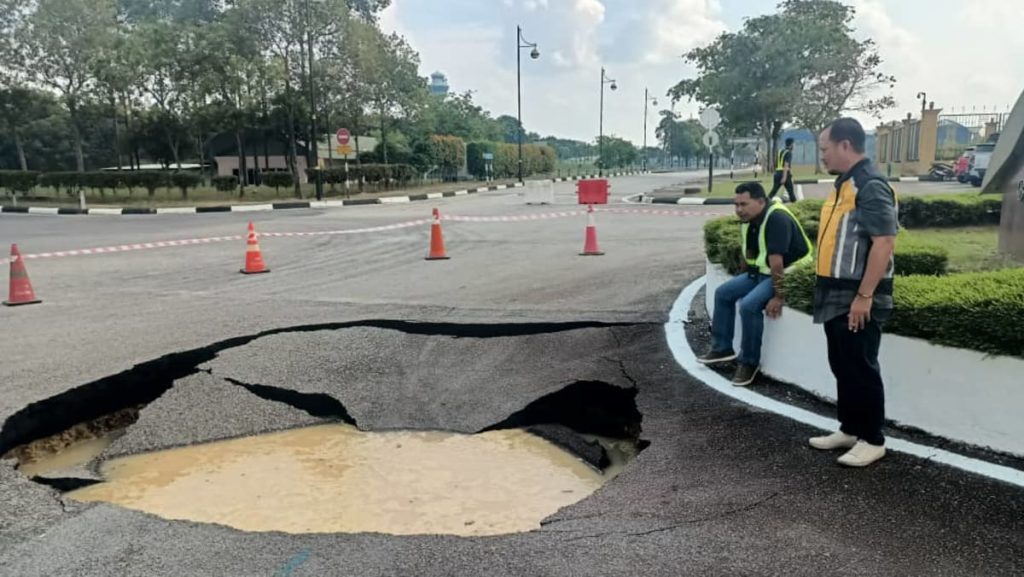The sinkhole that opened up in front of the Kuala Lumpur International Airport’s VIP complex in Malaysia was approximately 5 meters across and 1 meter deep. This occurrence took place near the entrance of the Bunga Raya complex and raised concerns about potential damage to the surrounding infrastructure. Initial investigations indicated that a sewage manhole belonging to KLIA was located nearby, leading to speculation that a burst sewage pipe might have been the cause of the sinkhole. The Works Ministry shared these findings in a Facebook post, prompting further examination of the situation.
Following the discovery of the sinkhole and the suspected burst sewage pipe, efforts were made to assess the extent of the damage and implement necessary repairs. The presence of a sewage manhole near the sinkhole suggested a connection between the two, leading experts to focus on addressing the issues within the sewage system. This incident raised concerns about the overall infrastructure maintenance at KLIA and the potential risks associated with similar sinkhole occurrences in the future. The Works Ministry’s involvement in investigating the situation and sharing updates on social media highlighted the importance of prompt communication and transparency in dealing with such incidents.
In response to the sinkhole incident, authorities at KLIA implemented measures to address the situation and prevent any further damage. Repair work was carried out to fix the burst sewage pipe and stabilize the sinkhole, ensuring the safety of the surrounding area. The coordinated efforts of the Works Ministry and KLIA officials helped in managing the aftermath of the sinkhole and minimizing disruptions to airport operations. This incident served as a reminder of the challenges faced in maintaining critical infrastructure like sewage systems and the importance of proactive maintenance to prevent such incidents.
The sinkhole incident near the Kuala Lumpur International Airport’s VIP complex highlighted the need for improved oversight and maintenance of infrastructure to prevent similar occurrences in the future. It also underscored the importance of conducting regular inspections and addressing potential issues promptly to avoid disruptions and ensure public safety. Authorities at KLIA and the Works Ministry worked together to investigate the sinkhole incident and take necessary actions to repair the damage. The incident prompted discussions on infrastructure resilience and the need for effective planning and maintenance strategies to minimize risks and protect public facilities from such incidents.
As news of the sinkhole near the Kuala Lumpur International Airport’s VIP complex spread, concerns were raised about the impact of such incidents on travel and public safety. The sinkhole’s proximity to the entrance of the Bunga Raya complex raised questions about the overall infrastructure stability and maintenance at KLIA. The Works Ministry’s involvement in investigating the incident and identifying the possible cause highlighted the importance of collaboration between government agencies and airport authorities in managing such situations. This incident served as a wakeup call for enhancing infrastructure resilience and implementing proactive measures to prevent similar incidents in the future.
In conclusion, the sinkhole incident at the Kuala Lumpur International Airport’s VIP complex in Malaysia raised awareness about the importance of infrastructure maintenance and oversight. The suspected burst sewage pipe that caused the sinkhole highlighted the need for regular inspections and prompt actions to address potential issues in sewage systems. The collaborative efforts of the Works Ministry and KLIA authorities in managing the situation underscored the importance of coordinated responses to infrastructure challenges. This incident also prompted discussions on infrastructure resilience and the need for proactive maintenance strategies to prevent disruptions and ensure public safety. Moving forward, it is essential for authorities to prioritize infrastructure maintenance and invest in measures to prevent similar incidents from occurring in the future.


